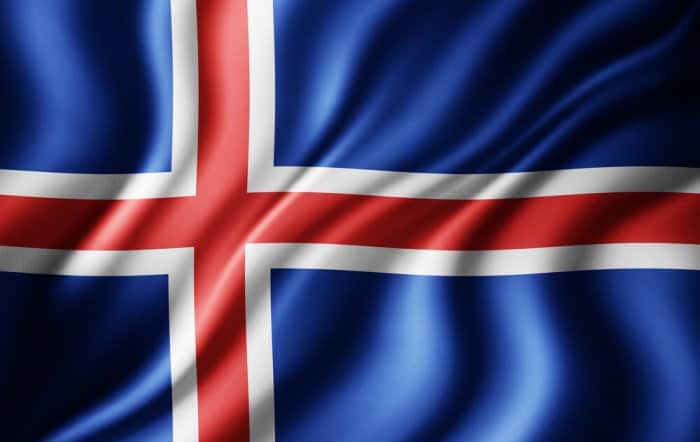A flag is the very identity of a country. By using a combination of colors and symbolism, a nation can convey its cultural values, stories, and histories. At its core, a flag is the ultimate device for communication. If you look at the flag of any country, any flag you know at least, a flurry of images, stories, historical events, languages, and foods will race through your mind. In my mind, Iceland’s flag is one of the more unique. No, I didn’t write that because I’m Icelandic. I promise. I say this more because I think that Icelanders and foreigners may not be aware of the history behind the Icelandic flag itself.

Iceland and Denmark
After the first Viking settlers landed, Iceland quickly became a commonwealth state governed by a parliament known as the Althingi. They realized they needed a way to settle disputes and make laws. However, while the Althingi had its say over domestic affairs in Iceland, they still pledged allegiance to Norway. Norway had tried long and hard to convert Icelanders from paganism to Christianity. When Norwegian King Olaf Tryggvason saw his opportunity to do just that, he jumped on it. Olaf sent two native Icelanders to Iceland in an attempt to convert them to Christianity. Both came back empty-handed and unsuccessful. Infuriated, the king forbid access to all Icelandic fisherman, took prominent Icelandic chieftains’ family members hostage, and ostensibly crippled the country’s economy. Iceland was in a dire situation at this point in its nation’s story.
No one is exactly sure of the date on Iceland’s history timeline, but around 999 or 1000 AD the country needed to make a decision: keep their traditional pagan customs and starve, or adopt Christianity and prosper with reopened Norwegian ports. Rival clans couldn’t come to a conclusion, so an arbitrator was issued by the Althingi. Thorgeir Thorkelsson reached what he thought was a good compromise: certain pagan customs could be worshipped in private, but Christianity would become the official religion of Iceland. Christianity won out, and with the island being a fiefdom of Norway, alongside the rise of the church, Iceland remained flag-less.

Norway’s male line of royal succession ended when King Olaf II died and we were absorbed into the Kalmar Union. Fate would have it though through a series of complicated political events, Denmark would gain control of the fishing waters surrounding Iceland. This resulted in Icelandic ships flying Danish flags over their bows. Iceland had no need for a flag because it claimed allegiance to other countries. Also, we would have only needed a flag if we were sailing, but we were in our own waters. Having your fertile fishing grounds ruled over by another entity doesn’t bode particularly well for a country whose chief export is fish.
The First Icelandic Flag is … Danish?
Funny enough, the first (semi) official flag came in the form of an ambitious Dane, named Jörgen Jörgensen who captured a British ship. What a name. I don’t know why, but his name is just fun to say. When Jörgen Jörgensen landed, his goal was to overthrow the government and name himself king. For a few brief weeks, he was a self-proclaimed ruler. And, what does every king need? A flag of course. The original flag was blue, and it had three stockfish positioned in its top right corner. His rule quickly ended, and his flag went with him. He was an interesting character, and his contemporaries referred to him as the “human comet”. His intention may have been to liberate Iceland, however it too little too late. But, I like to think his brief stint as usurper instilled an unshakable feeling in Icelanders that they should start considering autonomy.
In 1870 Icelandic artist Sigurdur Gudmundsson was inspired by the idea of giving the people a flag they could rally behind. His design featured a silver-grey falcon placed in front of a blue background. In 1874, the flag gained notoriety when Iceland celebrated its 1,000th year since original settlement. The design of the flag eventually drew criticism from those who said the international community would not adhere to it. It was too different. The general consensus at that time settled on a more conservative flag; a white Nordic cross against a blue background. The Nordic cross symbolizes Christian heritage, and it belongs to a group of one of the oldest symbols in the world. The cross generally sits off center to the left. This design would serve as the rallying cry for Icelandic sovereignty.

1874 was the first time that Iceland began to see an end to their long journey towards sovereignty. Denmark gave Iceland home rule, but home rule is far from autonomy. The local governments can make rules and laws, but the administrative body (Denmark) could ignore them or issue different ones instead. Flags of blue and white were ubiquitous during this time.
Iceland Gains Independence
After years of back and forth with the King of Norway, we finally gained independence in 1918. And with that, we received the first official Icelandic flag. Iceland’s flag is my favorite design of any flag in the world. It is a red Nordic cross resting on a larger, white Nordic cross against a robust blue background. I think that it does an incredible job conveying the physical attributes of Iceland. The red perfectly embodies our country’s rich abundance of lava fields, volcanoes, and geothermal springs. The white represents the frosty chill of the mountainous glaciers that cover our beautiful land. And lastly, blue resents the ocean and our seafaring culture.
Symbolism, History, and Meaning Behind Iceland’s Flag
This is a brief and incomplete history of Iceland and its flag, due mainly in part to lengthy political theatrics on the part of Norway when deciding on a flag design. Hopefully, you understand a little more history surrounding the banner that represents Iceland. We fought for over 1,000 years to gain our sovereignty. We were hassled and inundated with schemes and power struggles from mainland Europe. Our flag stands as a testament to our patience and determination, which makes us so uniquely Icelandic. Our environment has shaped us undoubtedly, but it isn’t the sum of who we are. Tell us, what’s your favorite flag and why?




